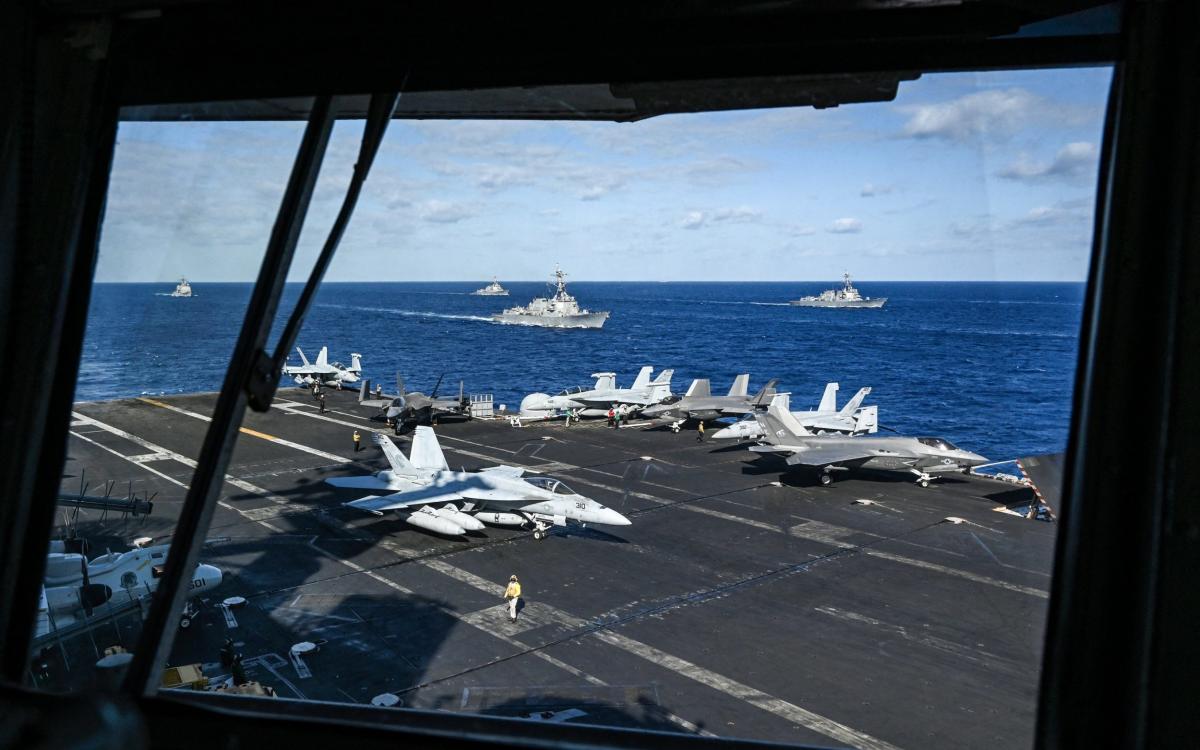After eight years of development, the US Air Force has finally cleared the new Northrop Grumman B-21 Raider stealth bomber for production.
The move comes just in time. The bomber is the key component in a stealthy reconnaissance-strike complex that could prove decisive in a major war with China over Taiwan – and that war is looking more and more likely in the wake of Taiwan’s January presidential election.
The winner, Lai Ching-te from the incumbent Democratic Progressive Party, is a staunch advocate of Taiwanese autonomy. Which, of course, the Chinese Communist Party considers a provocation.
The western Pacific is heating up. The batwing B-21, which the Pentagon revealed in a flashy ceremony back in December 2022, could act as a cooler.
But not without a little help. The US Air Force has always considered the radar-evading, subsonic B-21 – a high-tech successor to the 1980s-vintage B-2 stealth bomber – as part of a so-called “family of systems.” The bombers are supposed to work in teams with other aircraft.
The flying branch has declined to specify exactly which other aircraft might comprise the B-21 “family,” but it’s not hard to guess.
In the years before Northrop finished work on the 132-foot-wingspan Raider, it developed – in secrecy – a reconnaissance drone that looks almost exactly like the Raider, albeit without the two-person cockpit. Both types absorb and scatter radar waves in order to minimize their signatures on enemy scopes.
That drone, the RQ-180, flew under the radar – proverbially speaking – until 2013, when Aviation Week reporters Bill Sweetman and Amy Butler revealed its existence and detailed its possible capabilities in a blockbuster series of articles.
We didn’t actually see an RQ-180 until seven years later. In late 2020, photographer Rob Kolinsky snapped a photo of an apparent RQ-180 droning high over California. A year later another photographer, Michael Fugnit, snapped a shot of a possible RQ-180 winging over The Philippines.
It’s obvious what the RQ-180 does. We know, because we know what the RQ-180 is replacing. The US Air Force in recent years has been in an unseemly hurry to retire its long-serving RQ-4 spy drones and even longer-serving U-2 manned spy planes.
USAF leaders have justified cutting the high-flying RQ-4s and U-2s by citing the introduction of secret new systems that match the older planes’ surveillance capabilities – and also possess greater survivability. All that is to say, the US Air Force is confident the RQ-180 can safely fly directly over enemy territory in order to gather imagery and potentially register the locations of enemy sensors.
It’s apparent the RQ-180 is the hunter half of a stealthy hunter-killer team, where the killer is the B-21. The drones will spot targets for the bombers to strike with precision-guided cruise missiles and glide-bombs. The drones and bombers will be protected by their stealth, as well as by the long range of their sensors and munitions.
The combination is a potent one. It’s not for no reason that the US Air Force is so bullish on the B-21. The service aims to acquire at least 100 of the new bombers, and potentially nearly 200 – enough to replace 65 or so older B-2 and B-1 bombers while also growing the overall long-term bomber fleet, which will also include around 75 deeply-upgraded B-52 bombers.
The cost of the B-21s alone could exceed $200 billion. Add the cost of a couple of dozen RQ-180s plus thousands of missiles and bombs, and the price tag for the whole family of systems might be closer to $300 billion.
But few in the US defense establishment question this cost. If anything, the consensus seems to be that the US Air Force should try to find money for even more of the bombers.
The reason is obvious. Study after study, war game after war game, points to missile-armed bombers as the decisive weapons in any major war over Taiwan. When the Center for Strategic and International Studies in Washington, DC gamed out a Chinese invasion of Taiwan early last year, it concluded that US Air Force bombers working in conjunction with U.S. Navy submarines could decimate a Chinese invasion fleet and save Taiwan.
Think of the RQ-180-and-B-21 team as a high-tech version of Russia’s own crude reconnaissance-strike family of systems, which is responsible for the frequent, and bloody, missile raids on Ukrainian cities.
The Russian air force flies scores of Cold War-vintage bombers armed with equally aged cruise missiles. Every few weeks, the bombers take off, wing toward the Russia-Ukraine border and lose their cruise missiles from hundreds of miles away.
The raids are inaccurate and indiscriminate – and mostly damage civilian infrastructure and kill and maim civilians. That’s by choice, of course: it’s Russian policy to target Ukrainian civilians.
But it’s also by necessity. The Russian reconnaissance-strike complex is heavy on strike and light on reconnaissance, because the Russians have rough analogues of the Americans’ own bombers, but they don’t have anything like the RQ-180. They don’t, in other words, have any means of spotting fleeting targets from directly overhead.
With RQ-180s scouting for B-21s, the US Air Force should be able to aim its thousands of missiles and glide-bombs at targets with actual military value. Namely, the airfields, headquarters, supply depots and ships supporting a Chinese invasion of Taiwan.










